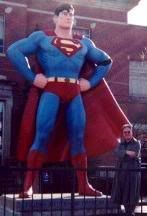| Pop Culture Gadabout | ||
|
Thursday, July 02, 2009 ( 7/02/2009 10:05:00 AM ) Bill S. THE GOLDEN CARP: Last year, as a part of its "Big Read" project, the NEA presented Rudolfo Anaya's Bless Me, Ultima as its recommended work. In my area, copies of the novel were given away in several scheduled book events throughout the last four months of 2008, all as a part of the Big Read's program to encourage reading in our country. The novel's selection was not without its controversy, at least within the heavily religious communities of Safford and Thatcher, AZ. At public issue were the book's occasional profanities and a scene where the book's seven-year-old narrator Antonio Márez spies on one of his brothers in a whorehouse, though I suspect that many of the loudest critics had a different agenda in condemning Anaya's novel. Ultima is set in WWII Era rural New Mexico: as such, it makes an intriguing companion piece to Richard Bradford's Red Sky at Morning, though where Bradford made his hero a transplanted southern white boy, Anaya's Antonio grows up in a bi-lingual Chicano home with a strong Catholic heritage. While both novels excel at portraying the workings of their young boys' minds and contain some very funny scenes centered on their school and friends, Antonio's story ultimately proves darker and occasionally frightening. The Ultima of the title is an elderly herbal healer who is staying with Antonio's family. Though many in the area -- most particularly, a vicious thug named Tenorio -- believe her to be a bruja, in practice we see that she's a benevolent figure, a curandera or healer. Still, her presence in the Márez home proves a lightning rod for Tenorio, who attempts to kill Ultima and our hero in the book. During the first attempt, an owl that we're told is connected to Ultima's spirit blinds Tenoria in one eye. The presence of the monstrous Tenorio in the town -- coupled with the fact that he's able to brazenly get away with dark deeds that seemingly go unpunished -- spurs the young Antonio into asking one of faith's big questions: if there's a God, why does he allow horrid things to happen? One of the strengths of Anaya's story rests in the way he captures both Mexican Catholic and Southwestern Indian religious traditions and depicts how these might commingle in a young boys' mind. Representing the latter is a local legend, the Golden Carp, who resides in a nearby river. While Antonio's mother harbors dreams of him eventually becoming a priest, the boy finds himself just as attracted to the nature-driven aspects of the region's Pueblo-based religions as he does the Virgin Mary. This is captured in the book through a series of dreams where the two religious symbols, Virgin Mother and Big Fish, are given equal voice. By the end of the novel, our young narrator has begun to work toward reconciling these two religious beliefs, toward blending them into a personalized spirituality. It's this aspect of the book, more than its occasional real-life English and Spanish obscenities, which made the book a target in my neck of Arizona, I suspect. Graham County is a largely religiously conservative area with a strong LDS population and a goodly amount of evangelically driven churches. The core theme of Bless Me, Ultima -- that affords similar weight to Christian and non-Christian religions -- is not one that sits well with the Harry Potter Is Evil bunch. Though the curandera Ultima takes great pains never to counter Antonio's very Catholic mother's take on things, her existence as a force for good in the community stands as a symbol of a different cosmology. For many hard-core religionists, even the suggestion that there might be more than One Way is reason enough to try to get this beautifully written and engaging story pulled off school library shelves. Me, I'm glad the controversy pushed the novel into the public dialog enough to nudge me into picking up one of the Big Read's free paperbacks and ultimately digging into it. Though it doesn't always work this way, the alarmists got me reading a pretty damn good book. Labels: cultural commentary # | |
|
|

